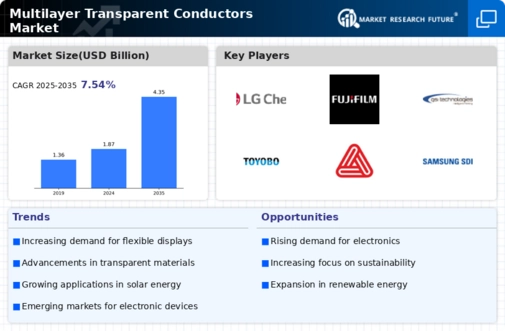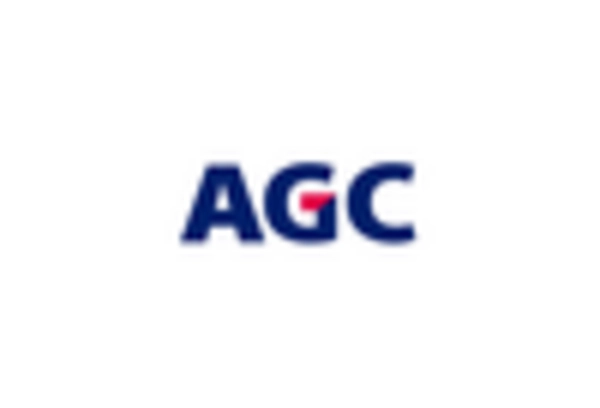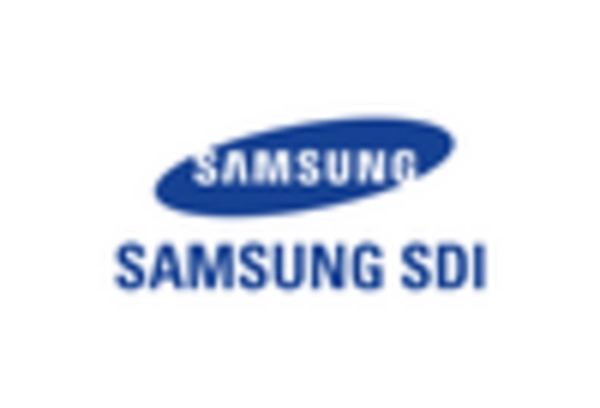Growth in Consumer Electronics
The Multilayer Transparent Conductors Market is benefiting from the rapid growth in the consumer electronics sector. With the proliferation of smartphones, tablets, and smart home devices, the demand for high-performance displays is escalating. Multilayer transparent conductors are essential for achieving the desired transparency and conductivity in these devices, which enhances user experience. The consumer electronics market is projected to reach over 1 trillion USD by 2025, indicating a substantial opportunity for multilayer transparent conductors. As manufacturers strive to meet consumer expectations for high-quality displays, the integration of these advanced materials is likely to become increasingly prevalent, thereby driving the growth of the Multilayer Transparent Conductors Market.
Rising Demand for Flexible Electronics
The Multilayer Transparent Conductors Market is experiencing a notable surge in demand for flexible electronics. This trend is largely driven by the increasing adoption of wearable devices, flexible displays, and smart textiles. As consumers seek more versatile and portable electronic solutions, manufacturers are compelled to innovate. The market for flexible electronics is projected to reach approximately 50 billion USD by 2026, indicating a robust growth trajectory. This demand for flexibility necessitates the use of multilayer transparent conductors, which offer superior conductivity and transparency, thereby enhancing the performance of these devices. Consequently, the expansion of the flexible electronics sector is likely to propel the growth of the Multilayer Transparent Conductors Market.
Advancements in Photovoltaic Technologies
The Multilayer Transparent Conductors Market is significantly influenced by advancements in photovoltaic technologies. As the world increasingly shifts towards renewable energy sources, the demand for efficient solar panels is on the rise. Multilayer transparent conductors play a crucial role in enhancing the efficiency of solar cells by improving light absorption and reducing energy loss. The solar energy market is expected to grow at a compound annual growth rate of over 20% in the coming years, which suggests a corresponding increase in the need for advanced conductive materials. This trend indicates that the Multilayer Transparent Conductors Market is poised for growth as manufacturers seek to integrate these materials into next-generation solar technologies.
Regulatory Support for Sustainable Materials
The Multilayer Transparent Conductors Market is positively impacted by regulatory support for sustainable materials. Governments and regulatory bodies are increasingly promoting the use of eco-friendly materials in various industries, including electronics and energy. This shift towards sustainability is driving manufacturers to adopt multilayer transparent conductors that are not only efficient but also environmentally friendly. The push for sustainable practices is expected to create new market opportunities, as companies seek to comply with regulations and meet consumer demand for greener products. Consequently, the Multilayer Transparent Conductors Market is likely to benefit from this regulatory environment, fostering growth and innovation in sustainable conductive materials.
Increased Investment in Research and Development
The Multilayer Transparent Conductors Market is witnessing increased investment in research and development activities. This trend is primarily driven by the need for innovative materials that can meet the evolving demands of various applications, including displays, sensors, and energy devices. Companies are allocating significant resources to develop new multilayer transparent conductor technologies that offer improved performance and cost-effectiveness. This focus on R&D is expected to yield breakthroughs that could enhance the functionality and applicability of these materials. As a result, the Multilayer Transparent Conductors Market is likely to experience accelerated growth, as new products and solutions emerge from these research initiatives.

















Leave a Comment